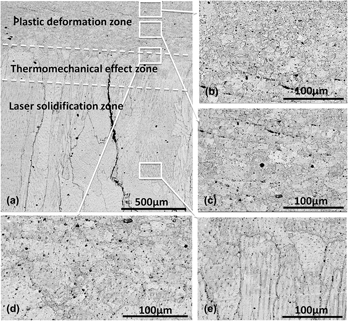Article contents
Laser solid forming assisted by friction stir processing for preparation of Ni–16Cr–8Fe alloys: Crack repairing and grain refinement
Published online by Cambridge University Press: 27 June 2018
Abstract

Although laser solid forming (LSF) has a wide range of applications in material manufacturing, the technique has been severely limited due to the solidification cracks during rapid laser melting/solidification. In this paper, an LSF technology assisted by friction stir processing (FSP) is proposed to eliminate the LSF crack through the FSP thermomechanical coupling effect, with the Ni–16Cr–8Fe alloy as a representative material. By FSP-assisted LSF, the cracks at the top surface of the Ni–16Cr–8Fe alloy layer were eliminated. Meanwhile, the severe plastic deformation layers can be observed and gradient grains with tens of nanometers to tens of micrometers from the top surface to the inner. The LSF-printed dendrite microstructure was transformed into nanocrystals or nanotwins in the deformation zone with twining as the main deformation mechanism. The grain refinement results in the increase of hardness about 30%.
- Type
- Article
- Information
- Copyright
- Copyright © Materials Research Society 2018
References
REFERENCES
- 2
- Cited by




